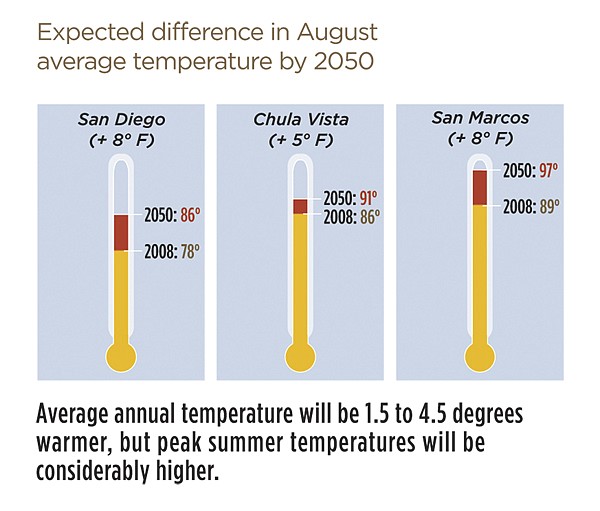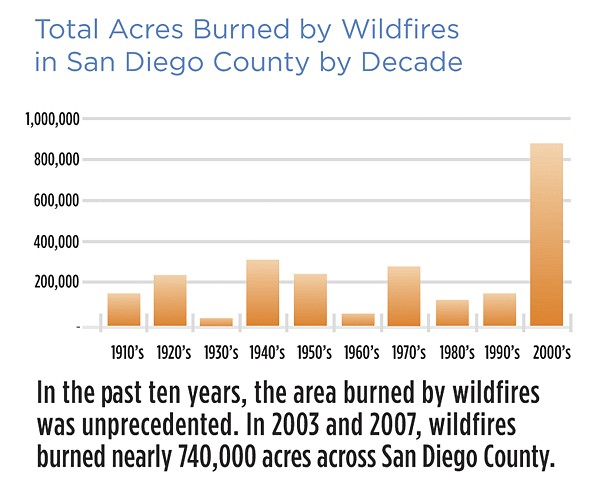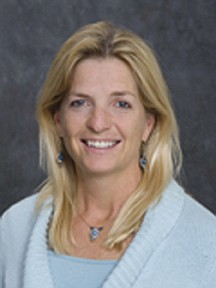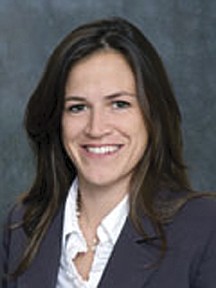 Facebook
Facebook
 X
X
 Instagram
Instagram
 TikTok
TikTok
 Youtube
Youtube

The data are in: climate change is real, and greenhouse gas emissions are greatly to blame. Global warming does not necessarily cause destructive disasters but definitely intensifies them.
The East Coast seems more vulnerable than the West, but San Diegans can’t gloat. In the past five years, several studies have predicted the devastation Southern California could suffer as a result of climate change.
One study, by Dan Cayan of the Scripps Institution of Oceanography, predicts that summer temperatures will increase sharply and “have severe impacts upon our public health and our supply of water and energy.” If greenhouse gas emissions continue to be high, by century’s end, heat-wave days “could increase by fourfold or more.” The sea level will rise, eroding coastal structures, shrinking beaches, and increasing “the chances of salt water intruding into our fresh water systems.” Severe flooding is possible.


And then there is drought. “Southern California has some of the riskiest wildfire conditions in the United States,” writes Cayan. “As climate changes, it appears that summer dryness will begin earlier, last longer and become more intense.” Multiple infernos could result.
Another study by the San Diego Foundation is titled “San Diego’s Changing Climate: A Regional Wake-Up Call.” The study starts out, “In 2050, if current trends continue, San Diego’s climate will be hotter and drier. Sea level will be 12–18 inches higher. We will face a severe water shortage. Wildfires will be more frequent and intense. Public health will be at risk, especially among our elderly and children. Native plant and animal species will be lost forever. We will not be able to meet our energy needs.”
There are a number of specific recommendations: reduce automobile usage; boost transit; make communities more compact and walkable; consider relocating threatened structures; stress water technologies such as recycling and desalination; scale back water usage; consider prohibiting development in fire-prone and certain coastal areas; and tighten building codes to mandate fire-resistant building design and materials.
The study warns that even if worldwide greenhouse gas emissions are reduced, “further warming is unavoidable as a result of past emissions that have built up in the atmosphere.”
This year, the City put out its draft study, “Climate Mitigation and Adaptation Plan,” or CMAP. It sounds some of the same alarms — but softly. San Diego’s most pressing question is whether the business establishment is capable of implementing changes that can negatively affect its pocketbook. After several delays, the plan is expected to come before the council in early 2013.

Although mayor-elect Bob Filner is more attuned to climate change than recent predecessors, many San Diegans worry that significant changes may not take place until nature mandates them. A group called SanDiego350.org is battling for more aggressive climate-change moves. “[The City’s plan] is not strong enough, does not meet its goals,” says Emily Wier, spokesperson for SanDiego350. “We are nowhere near on track for 2035 and 2050 goals. CMAP takes the low-hanging fruit — increasing bike lanes, encouraging people to carpool, the City purchasing more electric vehicles. But it does nothing to reduce our use of fossil fuels.”
One example: “It should be a no-brainer that all new buildings and existing buildings have solar panels on them,” says Wier.
Bill Powers of Powers Engineering agrees. His name is listed among those contributing to the City’s report, but he wants his name removed. “The plan is weak,” he says. “We have to really start rolling on solar on rooftops, but I have been hitting a brick wall.” The City’s plan uses obsolete statistics that inhibit the advance of solar power in a metro area with abundant sunshine. “I see the heavy presence of San Diego Gas & Electric saying, ‘We don’t want a serious impact on our business.’” (Sempra Energy, San Diego Gas & Electric’s parent, has among the highest profits of American utilities, and the local rates are among the nation’s steepest.)
The City’s plan has “incredibly modest targets” for smart-grid and renewable-energy technologies, says Powers.
The San Diego Association of Governments has been reporting on climate change, too. But at the same time, it has been hatching and effectuating plans for massive expansions of freeways. “SANDAG is a catastrophe as far as global warming is concerned,” says Jim Mills, former president pro tem of the California State Senate. The association of governments is bowing to “developers who want sprawl. Freeways do not solve traffic-congestion problems, they generate them” because distant housing developments spring up. “Expanding those freeways will cause more destruction than the Luftwaffe did on English cities in World War II.”
Conservation-minded groups have filed suit against the association, blasting the “automobile-oriented approach to transportation planning” in its 2050 Regional Transportation Plan. Smart growth will be the loser under the association, says the suit, which is scheduled to be decided November 30. “SANDAG proposes a ‘freeway-first’ system,” in which transit planning is wholly inadequate, says Duncan McFetridge, who has been pushing the suit.

The San Diego Foundation points to studies showing that an overwhelming majority of San Diegans wants movement on climate change, says Nicola Hedge, manager of the climate initiative. This suggests people are not questioning the science, she says. She believes the business community will line up behind the efforts, pointing to “the robust clean-tech sector in the region.”
“The good news is that all the cities and the county are developing greenhouse gas inventories,” says Emily Young, director of environment analysis and strategy at the foundation. “We haven’t gotten that far down the road with the development community, but more developers are looking at opportunities to develop existing areas to help reduce the urban footprint.”
But skepticism abounds. Norma Damashek, former president of the San Diego League of Women Voters, says San Diego has great scientific institutions doing pioneering research on the topic, “but they are not taking leadership in the City.” The scientific community must get aggressive in league with political leaders, she says. “This is a national issue that could put us on the map.” ■


The data are in: climate change is real, and greenhouse gas emissions are greatly to blame. Global warming does not necessarily cause destructive disasters but definitely intensifies them.
The East Coast seems more vulnerable than the West, but San Diegans can’t gloat. In the past five years, several studies have predicted the devastation Southern California could suffer as a result of climate change.
One study, by Dan Cayan of the Scripps Institution of Oceanography, predicts that summer temperatures will increase sharply and “have severe impacts upon our public health and our supply of water and energy.” If greenhouse gas emissions continue to be high, by century’s end, heat-wave days “could increase by fourfold or more.” The sea level will rise, eroding coastal structures, shrinking beaches, and increasing “the chances of salt water intruding into our fresh water systems.” Severe flooding is possible.


And then there is drought. “Southern California has some of the riskiest wildfire conditions in the United States,” writes Cayan. “As climate changes, it appears that summer dryness will begin earlier, last longer and become more intense.” Multiple infernos could result.
Another study by the San Diego Foundation is titled “San Diego’s Changing Climate: A Regional Wake-Up Call.” The study starts out, “In 2050, if current trends continue, San Diego’s climate will be hotter and drier. Sea level will be 12–18 inches higher. We will face a severe water shortage. Wildfires will be more frequent and intense. Public health will be at risk, especially among our elderly and children. Native plant and animal species will be lost forever. We will not be able to meet our energy needs.”
There are a number of specific recommendations: reduce automobile usage; boost transit; make communities more compact and walkable; consider relocating threatened structures; stress water technologies such as recycling and desalination; scale back water usage; consider prohibiting development in fire-prone and certain coastal areas; and tighten building codes to mandate fire-resistant building design and materials.
The study warns that even if worldwide greenhouse gas emissions are reduced, “further warming is unavoidable as a result of past emissions that have built up in the atmosphere.”
This year, the City put out its draft study, “Climate Mitigation and Adaptation Plan,” or CMAP. It sounds some of the same alarms — but softly. San Diego’s most pressing question is whether the business establishment is capable of implementing changes that can negatively affect its pocketbook. After several delays, the plan is expected to come before the council in early 2013.

Although mayor-elect Bob Filner is more attuned to climate change than recent predecessors, many San Diegans worry that significant changes may not take place until nature mandates them. A group called SanDiego350.org is battling for more aggressive climate-change moves. “[The City’s plan] is not strong enough, does not meet its goals,” says Emily Wier, spokesperson for SanDiego350. “We are nowhere near on track for 2035 and 2050 goals. CMAP takes the low-hanging fruit — increasing bike lanes, encouraging people to carpool, the City purchasing more electric vehicles. But it does nothing to reduce our use of fossil fuels.”
One example: “It should be a no-brainer that all new buildings and existing buildings have solar panels on them,” says Wier.
Bill Powers of Powers Engineering agrees. His name is listed among those contributing to the City’s report, but he wants his name removed. “The plan is weak,” he says. “We have to really start rolling on solar on rooftops, but I have been hitting a brick wall.” The City’s plan uses obsolete statistics that inhibit the advance of solar power in a metro area with abundant sunshine. “I see the heavy presence of San Diego Gas & Electric saying, ‘We don’t want a serious impact on our business.’” (Sempra Energy, San Diego Gas & Electric’s parent, has among the highest profits of American utilities, and the local rates are among the nation’s steepest.)
The City’s plan has “incredibly modest targets” for smart-grid and renewable-energy technologies, says Powers.
The San Diego Association of Governments has been reporting on climate change, too. But at the same time, it has been hatching and effectuating plans for massive expansions of freeways. “SANDAG is a catastrophe as far as global warming is concerned,” says Jim Mills, former president pro tem of the California State Senate. The association of governments is bowing to “developers who want sprawl. Freeways do not solve traffic-congestion problems, they generate them” because distant housing developments spring up. “Expanding those freeways will cause more destruction than the Luftwaffe did on English cities in World War II.”
Conservation-minded groups have filed suit against the association, blasting the “automobile-oriented approach to transportation planning” in its 2050 Regional Transportation Plan. Smart growth will be the loser under the association, says the suit, which is scheduled to be decided November 30. “SANDAG proposes a ‘freeway-first’ system,” in which transit planning is wholly inadequate, says Duncan McFetridge, who has been pushing the suit.

The San Diego Foundation points to studies showing that an overwhelming majority of San Diegans wants movement on climate change, says Nicola Hedge, manager of the climate initiative. This suggests people are not questioning the science, she says. She believes the business community will line up behind the efforts, pointing to “the robust clean-tech sector in the region.”
“The good news is that all the cities and the county are developing greenhouse gas inventories,” says Emily Young, director of environment analysis and strategy at the foundation. “We haven’t gotten that far down the road with the development community, but more developers are looking at opportunities to develop existing areas to help reduce the urban footprint.”
But skepticism abounds. Norma Damashek, former president of the San Diego League of Women Voters, says San Diego has great scientific institutions doing pioneering research on the topic, “but they are not taking leadership in the City.” The scientific community must get aggressive in league with political leaders, she says. “This is a national issue that could put us on the map.” ■
Comments